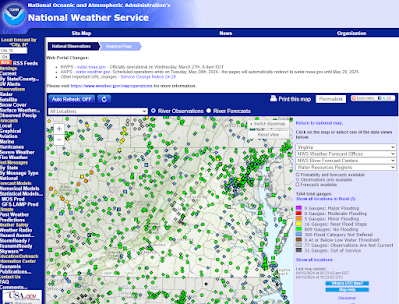Informational video in which RISE Executive Director Paul Robinson and Wise County GISP Jessica Swinney discuss challenges facing SW Virginia.
Flooding has been a longstanding concern in Southwest Virginia, where the region's topography and weather patterns have created recurring challenges for communities. From historical events to modern impacts, understanding the root causes and historical context of flooding in this area is crucial for addressing current and future issues effectively.
A Legacy of Vulnerability
The history of flooding in Southwest Virginia can be traced back to its geographical features. The region's mountainous terrain and proximity to waterways like the Clinch and Powell rivers have made it particularly susceptible to flash floods and river overflow. Settlements in valleys and low-lying areas have faced the brunt of these natural phenomena throughout history.
Historical Events
Several significant flooding events have left a mark on Southwest Virginia's history. The floods of 1877, 1940, and 1977 stand out as particularly devastating episodes that impacted local communities. The flood of 1977, in particular, caused widespread destruction and led to significant changes in floodplain management and disaster preparedness efforts in the region.
Challenges in Modern Times
Despite advancements in flood control and management practices, Southwest Virginia continues to face flooding challenges. Urbanization, changing weather patterns due to climate change, and aging infrastructure exacerbate the risks associated with flooding. Additionally, the growing impact of land use practices on watersheds further complicates mitigation efforts.
Mitigation and Adaptation Efforts
Over the years, local and state authorities, along with community organizations, have implemented various measures to address flooding issues. This includes levees, floodwalls, and improved warning systems. Additionally, initiatives focusing on wetland restoration and natural floodplain management are gaining traction as sustainable solutions to reduce flood risks.
Looking Ahead
The future of flood management in Southwest Virginia requires a holistic approach that combines historical knowledge with innovative strategies. Building resilient communities involves investing in infrastructure upgrades, enhancing early warning systems, and promoting sustainable land use practices. Furthermore, engaging local communities in flood preparedness and response efforts is essential for long-term success.
Conclusion
In conclusion, Southwest Virginia's historic issues with flooding underscore the need for comprehensive and proactive approaches to mitigate risks and build resilience. By learning from past events and leveraging modern technologies and practices, the region can navigate its flood-prone landscape more effectively. Continued collaboration between stakeholders, supported by state-of-the-art flood management techniques, will be key to safeguarding Southwest Virginia's communities against future flooding challenges.
Helpful Links:
- Virginia Department of Conservation and Recreation - Flood Risk Management
- U.S. Geological Survey - Virginia Water Science Center
- National Weather Service - Advanced Hydrologic Prediction Service







